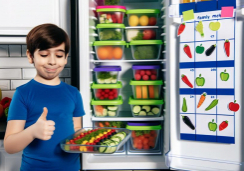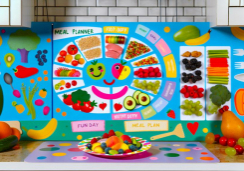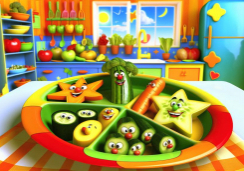7 Best Strategies for Picky Eaters' Meal Planning
As you navigate the rocky terrain of meal planning for your picky eater, it's crucial to have a compass to guide you through the tumultuous landscape of tastes and textures.
You've probably faced the standoff at the dinner table, where the peas remain untouched, and the chicken is prodded suspiciously. But don't let this be your mealtime tale night after night.
By employing a handful of effective strategies, you can transform dinner battles into opportunities for exploration and maybe even enjoyment. From involving your kids in the planning process to creating a positive mealtime routine, there's a smorgasbord of tactics to suit even the most discerning young palate.
As you venture forth, keep in mind the delicate balance between offering choices and standing firm on nutrition. Stay tuned to uncover these seven strategies that promise to tip the scales in favor of harmony and health at your family's table.
Identify Preferred Foods
To accommodate your picky eater's preferences, start by observing the specific foods they're consistently drawn to, noting their favored textures, colors, and flavors for insightful meal planning. This knowledge serves as your foundation for introducing new foods that are similar to their preferred choices.
For instance, if your child enjoys the crunchiness of apples, they might be open to trying new foods with a similar texture, like pear slices or carrot sticks.
Keep a detailed record of these preferred foods and use it to guide your meal planning. Gradually incorporate new options within the same category to expand their palate. If your picky eater favors orange-colored foods like carrots, you could introduce sweet potatoes or pumpkin to provide a variety of nutrients while still aligning with their color preference.
Paying attention to patterns in their picky eating habits can offer valuable insights. Maybe they're more likely to try foods that are separated rather than mixed. Use this information to present new foods in a more appealing way.
Involve Kids in Planning
You can boost your child's enthusiasm for meals by letting them pick their favorite ingredients for the menu.
Create an interactive meal chart together, which will give them a sense of control and may increase their willingness to try new foods.
This approach not only makes mealtime more fun but also ensures that they're learning about balanced nutrition in an engaging way.
Selecting Favorite Ingredients
Engaging children in selecting ingredients for meal planning not only respects their preferences but also paves the way for them to embrace new foods with enthusiasm. When you involve your kids, they're more likely to be excited about trying different flavors and healthy food options.
Start by including their favorite ingredients in the mix. This could be certain fruits, vegetables, or protein sources that they're already fond of. Then, introduce them to 'build your own' meal nights, where picky eaters can experiment with various components to create something they'll enjoy.
This strategy provides a balance by ensuring meals contain familiar tastes while gently nudging them towards new, nutritious choices. Remember, giving them this control and involvement can transform meal planning into a fun, educational activity.
Interactive Meal Chart
Incorporate an interactive meal chart into your routine, inviting your child to participate in the meal planning process and select from a variety of nutritious options. This approach can be a game-changer for your picky eater meal plan, turning mealtime struggles into opportunities for exploration and choice.
Here's how you can make the most of it:
- Offer a balanced array of foods, giving your child the freedom to choose their components.
- Introduce new flavors in a playful, pressure-free setting to encourage them to try new things.
- Present food separately to empower them with more control and less intimidation.
Plan Balanced Snacks
Kick off your snack planning by choosing a combo of proteins, healthy fats, and fibers to keep your kids energized and full until their next meal. When planning balanced snacks for your picky eaters, it's crucial to create an appealing assortment that caters to their unique taste while maintaining healthy eating principles. Offer a variety of options like crunchy vegetables, such as shredded carrots, paired with a rich peanut sauce, which provides a satisfying mix of flavors and textures.
Incorporate fruits, nuts, yogurt, whole grain crackers, and cheese into your meal planning. These foods not only offer essential nutrients but also come in handy for quick and easy snack preparation. By presenting snacks like fruit kabobs or veggie faces, you turn snack time into a fun activity, increasing the likelihood of acceptance from picky eaters.
Remember to establish designated snack times to prevent grazing that can lead to overeating. Portion control is key in managing energy levels and maintaining a healthy weight. Involve your children in the snack preparation process to boost their interest in trying new foods. This hands-on approach promotes a sense of ownership and may help alleviate the stress of mealtime battles.
Introduce Foods Gradually
After establishing a routine with balanced snacks, it's time to start introducing your picky eaters to new foods in small, manageable portions. Meal planning for picky eaters can be challenging, but the key is to introduce foods gradually.
Here's how you can plan meals that incorporate something new without overwhelming them:
- Begin with tiny tastes. Offer a small portion of a new food alongside familiar favorites. This doesn't make the new item seem daunting, and it allows your child to acclimate to the new flavors and textures at their own pace.
- Mix new with known. Slowly integrate new foods into dishes your child already enjoys. For example, add a few pieces of a new vegetable into their favorite pasta sauce or casserole.
- Turn exploration into a game. Encourage your kids to touch, smell, and play with the new food. This can help build familiarity and make them more open to trying it.
Offer Customizable Options
When you create mix-and-match meals or build-your-own plates, you empower your picky eater with choices that are both appealing and nutritionally balanced.
Offering a range of healthy components lets them construct a meal that suits their taste preferences while still meeting their dietary needs.
This approach not only respects their autonomy but also encourages them to explore new textures and flavors at a comfortable pace.
Mix-and-Match Meals
How can you cater to a picky eater's preferences while ensuring they receive a balanced diet? Offering mix-and-match meals with a variety of customizable options allows children to take control of their food choices in a fun and engaging way. When meal prepping for picky eaters, consider incorporating:
- A colorful array of vegetables and fruits for them to choose from.
- Protein options that can be easily added or swapped in an easy recipe.
- Whole grains or starchy vegetables to round out the meal.
This approach to your Meal Plan for Picky eaters will encourage them to engage in the food experience without feeling overwhelmed.
Before grocery shopping, involve your child in the selection process to build anticipation for the mix-and-match meals ahead.
Build-Your-Own Plates
To accommodate the varied tastes of picky eaters, consider offering build-your-own plate options that empower them to select from a diverse array of nutritious foods. This meal plan strategy allows even the pickiest eaters to control their food choices, increasing their willingness to eat.
By incorporating a balanced offering of proteins, vegetables, grains, and fruits, you can ensure that the whole family receives a nutrient-dense meal. Build-your-own plates also provide an excellent opportunity to introduce new or previously disliked foods in a non-pressured setting.
As everyone assembles their plates to please their individual palates, you're fostering a positive mealtime environment and encouraging a broader acceptance of wholesome foods.
Create a Mealtime Routine
Establishing a consistent mealtime routine can significantly enhance your picky eater's relationship with food, setting the stage for healthier eating habits and a more positive dining experience. A predictable schedule not only helps regulate appetite but also builds a sense of security around eating. When you're consistent with meal and snack times, your child knows what to expect, which can reduce anxiety and picky behaviors.
Here are a few meal prep tips that can help create a structured mealtime routine:
- Set regular times for meals and snacks to help your child anticipate when they'll eat next.
- Keep the atmosphere at the dinner table calm and free from distractions, making it easier for your child to focus on their meal.
- Get your child involved in Weekly Meal Prep and Menu Planning to pique their interest in the food they'll be eating.
Reinforce Positive Experiences
Celebrating your child's willingness to try new foods reinforces positive eating experiences and can gradually reshape their approach to a broader diet. When they show interest in a new dish, such as a chicken stir fry, acknowledge their curiosity. It's not just about the chicken they're trying; it's the flavors, textures, and even the vibrant colors on their plate that you're applauding. This positive reinforcement can make mealtime a joy rather than a battleground.
A registered dietitian would suggest making meal planning a collaborative effort. Involve your child in selecting pasta dishes or deciding between lemon or lime juice for a marinade. This involvement gives them a sense of control and sets the stage for a positive experience when they sit down to eat.
Keep the mealtime environment upbeat and remember to offer their favorite foods alongside the new ones. Maybe that pasta dish could include a familiar sauce even as you introduce a new vegetable. And don't forget presentation—making a smiley face with veggies or creating a colorful fruit mosaic can encourage a picky eater to dive into the meal with enthusiasm.
Frequently Asked Questions
How Do You Make a Meal Plan for a Picky Eater?
To make a meal plan, involve kids in flavor exploration and texture variations. Stay within comfort zones but serve small portions. Always use positive reinforcement to encourage trying new foods. Keep it nutrient-focused.
What Are the 5 P's of Picky Eating?
The 5 P's of picky eating include taste exploration, texture acceptance, food pairing, positive reinforcement, and creative presentation. They promote sensory engagement and are crucial for developing healthy, age-appropriate eating habits.
How Do You Meal Prep When You're Picky?
To meal prep as a picky eater, engage in ingredient exploration and flavor pairing. Try texture variation, comfort customization, and creative presentation. Always use positive reinforcement for trying new foods, focusing on nutrients for your age.
What Is the Best Diet for Picky Eaters?
You should focus on a diet with varied textures and flavor exploration, emphasizing comfort foods and nutrient pairing. Sensory play and creative presentation can make meals more appealing and nutritionally balanced for picky eaters.
Conclusion
You've got this! Keep offering a variety of foods, even those once refused.
Stay calm at mealtimes and let your child's hunger guide them.
Model healthy choices yourself, and remember, you provide the options, but your child decides what to eat.
Don't underestimate the power of touch, sight, and smell in food exploration.
Above all, embrace the Division of Responsibility to foster a stress-free, nutritious eating environment.
Your patience and consistency are key to expanding your picky eater's palate.










